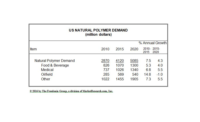U.S. demand for aseptic packaging to exceed $5 billion in 2015

Pharmaceuticals were the largest aseptic packaging market in 2010, accounting for 64% of the total. Opportunities will be driven by preferences among health care providers for unit-dose delivery formats.
Growth for aseptic packaging in the beverage market will be restrained by the maturity of the fruit beverage market, expectation among U.S. consumers for chilled milk and competition from hot-fill packaging, which has a well-established base. Gains in the food market will be driven by shelf-stability advantages, as well as by expanding applications in liquid, low-particulate and pumpable foods, often via the replacement of metal cans and glass jars.
Looking for a reprint of this article?
From high-res PDFs to custom plaques, order your copy today!





